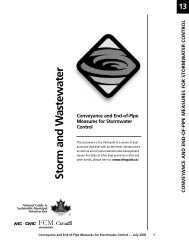Whitehorse Climate Change Adaptation Plan - Yukon College
Whitehorse Climate Change Adaptation Plan - Yukon College
Whitehorse Climate Change Adaptation Plan - Yukon College
You also want an ePaper? Increase the reach of your titles
YUMPU automatically turns print PDFs into web optimized ePapers that Google loves.
The broader community was engaged through a series of open houses, beginning with an<br />
introductory open house in June 2009 to promote the project. A total of four open houses<br />
and three workshops were held in the community over the course of the two-year adaptation<br />
project, from June 2009 to June 2011.<br />
LIMITATIONS OF THE WHITEHORSE ADAPTATION PLAN<br />
The <strong>Whitehorse</strong> adaptation plan makes recommendations to increase the resilience of<br />
<strong>Whitehorse</strong> based on the assessment of climate change vulnerability. The plan was developed<br />
through a rigorous process, which emphasized local knowledge and its integration with scientific<br />
information. However, given the broad nature of the assessment, the plan is necessarily limited<br />
by the availability and quality of data, the diversity of the community, and our emphasis on<br />
qualitative information.<br />
<strong>Climate</strong> change will affect almost every facet of <strong>Yukon</strong> and the people who live in it. Assessing<br />
this complex system is challenging and uncertainty is a significant component of climate change<br />
research (Malone and Brenkert, 2008). While the <strong>Whitehorse</strong> adaptation planning process was<br />
designed to manage uncertainty to the greatest degree possible, data gaps do exist. Therefore,<br />
the <strong>Whitehorse</strong> adaptation plan should be revisited regularly as new information emerges and<br />
the uncertainty associated with adaptation planning is reduced.<br />
The <strong>Whitehorse</strong> region is also remarkably complex. As will be described in the next section, the<br />
area is composed of extensive infrastructure, a number of interrelated governing bodies, and<br />
a relatively diverse population and economy. This complexity has been challenging to appraise<br />
given the broad nature of the adaptation plan. Extreme or special cases characterized by a<br />
high level of uncertainty have been especially challenging to evaluate. Such cases include a<br />
population expansion well beyond that indicated by current trends (or conversely a population<br />
decline), exceptional disaster situations, and/or regime shifts at an unprecedented rate of<br />
change. Our recommendations have been developed based on the information that could be<br />
gathered and supported by local, professional and academic technical knowledge. It should<br />
also be noted that an increase in community resilience through the timely implementation of<br />
adaptation strategies will buffer <strong>Whitehorse</strong> against some or all of the vulnerabilities associated<br />
with unprecedented and/or extreme events.<br />
The use of spatial information in this report has been largely used to support the observations<br />
provided to us by the community and by the Local and Technical Advisory committees.<br />
Quantitative information has therefore not played a significant role in the planning process.<br />
In part, our reliance on qualitative data has arisen due to the emphasis on local and technical<br />
knowledge in the plan. Quantitative data has also been challenging to integrate due to the broad<br />
nature and suite of issues that this plan addresses. As uncertainty is addressed and additional<br />
information becomes available, it is likely that a greater emphasis can be placed on quantitative<br />
information in the adaptation planning process. It is encouraged that quantitative information is<br />
integrated into future versions of this adaptation plan as opportunity allows.<br />
WHITEHORSE COMMUNITY PROFILE<br />
<strong>Whitehorse</strong> <strong>Climate</strong> <strong>Change</strong> <strong>Adaptation</strong> <strong>Plan</strong><br />
Many factors create the unique characteristics that define <strong>Whitehorse</strong> and its vulnerability and<br />
resilience to climate change. Some of these characteristics stem from the community, such as<br />
the demographic profile of residents, their history of addressing hazards, their education, and<br />
the economy. Other characteristics emerge from the landscape (e.g., biophysical profile of the<br />
community), which determines the susceptibility of the region to environmental stresses and<br />
11

















